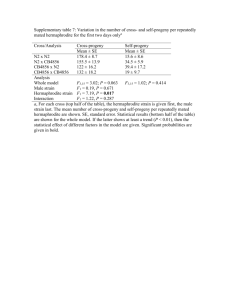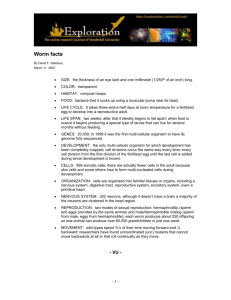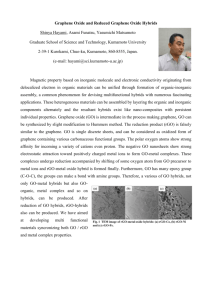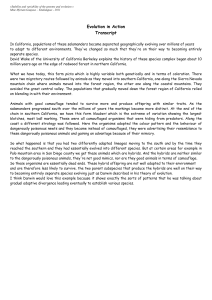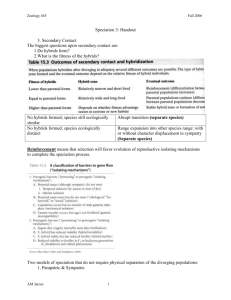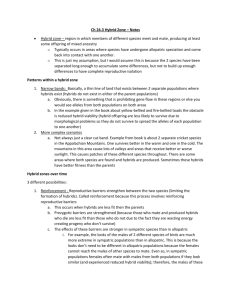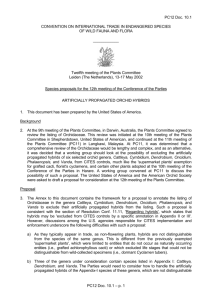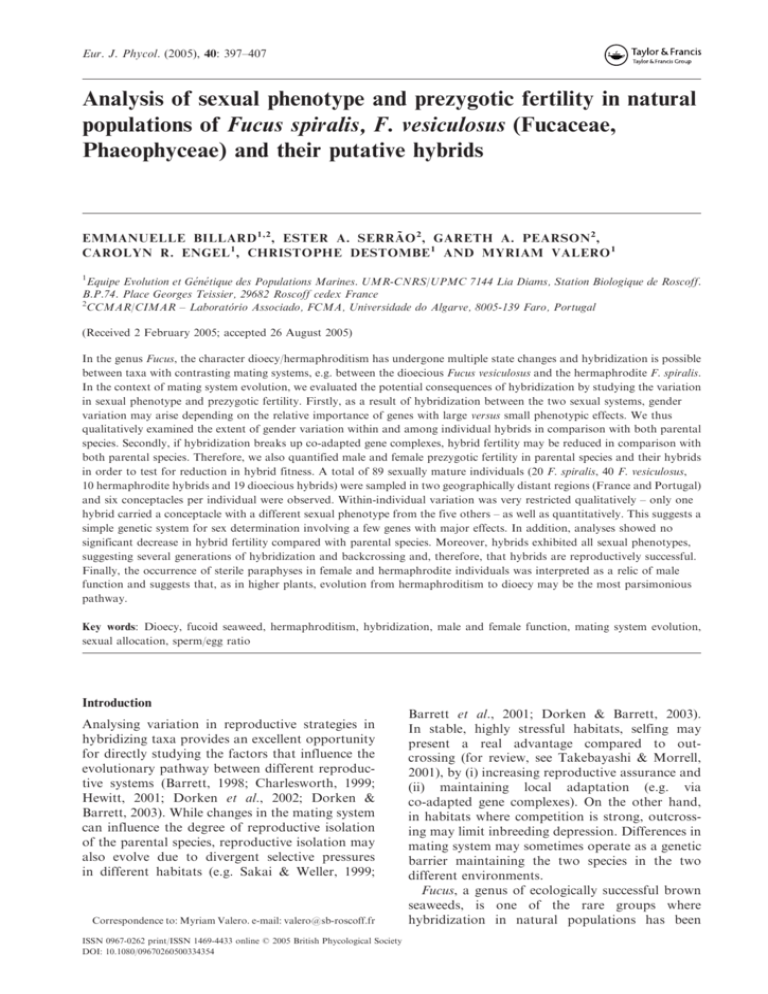
Eur. J. Phycol. (2005), 40: 397–407
Analysis of sexual phenotype and prezygotic fertility in natural
populations of Fucus spiralis, F. vesiculosus (Fucaceae,
Phaeophyceae) and their putative hybrids
EMMANUELLE BILLARD 1,2 , ESTER A. SERRÃO 2 , GARETH A. PEARSON 2 ,
CAROLYN R. ENGEL 1 , CHRISTOPHE DESTOMBE 1 AND MYRIAM VALERO 1
1
Equipe Evolution et Ge´ne´tique des Populations Marines. UMR-CNRS/UPMC 7144 Lia Diams, Station Biologique de Roscoff.
B.P.74. Place Georges Teissier, 29682 Roscoff cedex France
2
CCMAR/CIMAR – Laboratório Associado, FCMA, Universidade do Algarve, 8005-139 Faro, Portugal
(Received 2 February 2005; accepted 26 August 2005)
In the genus Fucus, the character dioecy/hermaphroditism has undergone multiple state changes and hybridization is possible
between taxa with contrasting mating systems, e.g. between the dioecious Fucus vesiculosus and the hermaphrodite F. spiralis.
In the context of mating system evolution, we evaluated the potential consequences of hybridization by studying the variation
in sexual phenotype and prezygotic fertility. Firstly, as a result of hybridization between the two sexual systems, gender
variation may arise depending on the relative importance of genes with large versus small phenotypic effects. We thus
qualitatively examined the extent of gender variation within and among individual hybrids in comparison with both parental
species. Secondly, if hybridization breaks up co-adapted gene complexes, hybrid fertility may be reduced in comparison with
both parental species. Therefore, we also quantified male and female prezygotic fertility in parental species and their hybrids
in order to test for reduction in hybrid fitness. A total of 89 sexually mature individuals (20 F. spiralis, 40 F. vesiculosus,
10 hermaphrodite hybrids and 19 dioecious hybrids) were sampled in two geographically distant regions (France and Portugal)
and six conceptacles per individual were observed. Within-individual variation was very restricted qualitatively – only one
hybrid carried a conceptacle with a different sexual phenotype from the five others – as well as quantitatively. This suggests a
simple genetic system for sex determination involving a few genes with major effects. In addition, analyses showed no
significant decrease in hybrid fertility compared with parental species. Moreover, hybrids exhibited all sexual phenotypes,
suggesting several generations of hybridization and backcrossing and, therefore, that hybrids are reproductively successful.
Finally, the occurrence of sterile paraphyses in female and hermaphrodite individuals was interpreted as a relic of male
function and suggests that, as in higher plants, evolution from hermaphroditism to dioecy may be the most parsimonious
pathway.
Key words: Dioecy, fucoid seaweed, hermaphroditism, hybridization, male and female function, mating system evolution,
sexual allocation, sperm/egg ratio
Introduction
Analysing variation in reproductive strategies in
hybridizing taxa provides an excellent opportunity
for directly studying the factors that influence the
evolutionary pathway between different reproductive systems (Barrett, 1998; Charlesworth, 1999;
Hewitt, 2001; Dorken et al., 2002; Dorken &
Barrett, 2003). While changes in the mating system
can influence the degree of reproductive isolation
of the parental species, reproductive isolation may
also evolve due to divergent selective pressures
in different habitats (e.g. Sakai & Weller, 1999;
Correspondence to: Myriam Valero. e-mail: valero@sb-roscoff.fr
ISSN 0967-0262 print/ISSN 1469-4433 online ß 2005 British Phycological Society
DOI: 10.1080/09670260500334354
Barrett et al., 2001; Dorken & Barrett, 2003).
In stable, highly stressful habitats, selfing may
present a real advantage compared to outcrossing (for review, see Takebayashi & Morrell,
2001), by (i) increasing reproductive assurance and
(ii) maintaining local adaptation (e.g. via
co-adapted gene complexes). On the other hand,
in habitats where competition is strong, outcrossing may limit inbreeding depression. Differences in
mating system may sometimes operate as a genetic
barrier maintaining the two species in the two
different environments.
Fucus, a genus of ecologically successful brown
seaweeds, is one of the rare groups where
hybridization in natural populations has been
E. Billard et al.
reported between taxa possessing contrasting
mating systems. Hybridization between cosexual
hermaphrodite and unisexual dioecious species
has been suggested by the observation of intermediate thallus morphologies in the field between
cosexual F. spiralis and unisexual F. ceranoides
(Gard, 1910), as well as field observations and/or
laboratory crosses between F. spiralis and
unisexual F. vesiculosus (Sauvageau, 1909; Kniep,
1925; Burrows & Lodge, 1951; Scott & Hardy,
1994) and between cosexual F. evanescens and
unisexual F. serratus (Lein, 1984; Rice &
Chapman, 1985; Coyer et al., 2002), and has been
recently confirmed in natural populations using
molecular markers for the latter two species pairs
(Coyer et al., 2002; Wallace et al., 2004, Engel
et al., 2005).
Vernet & Harper (1980) advanced the hypothesis
of contrasting selective pressures – abiotic on the
upper shore and biotic on the lower shore – driving
divergence in mating systems in F. spiralis and
F. vesiculosus, which co-occur throughout most of
their distributional range. Typically, the vertical
distribution of the species is discontinuous (parapatric situation) where hermaphrodite F. spiralis
is present in the high intertidal zone and dioecious
F. vesiculosus in the mid-intertidal zone. However,
individuals of the two species can be found in
contiguous stands (sympatric situation) in the
transition zone and on shores with complex
topology. On average, due to their overlapping
but distinct vertical distributions on the shore,
F. spiralis individuals are emersed at low tide for
longer than F. vesiculosus individuals, and are
therefore subjected to different selective pressures
in response to abiotic stress. Although laboratory
studies of emersion stress reveal little difference in
tolerance between F. spiralis and F. vesiculosus
(e.g. Dring & Brown, 1982), field studies suggest
that (sublethal) emersion stress mediates competitive interactions (perhaps between early postsettlement or juvenile stages). For example, it has
been shown that F. vesiculosus can extend its
vertical range upshore when F. spiralis is removed
(Hawkins & Hartnoll, 1985; Chapman & Johnson,
1990); however, F. spiralis is competitively
excluded by F. vesiculosus in the midshore region
(Chapman, 1990; see reviews by Chapman, 1995;
Davison & Pearson, 1996).
In Fucus, the character dioecy/hermaphroditism
has undergone multiple state changes (Serrão et al.,
1999). Although the sister taxa to Fucus are
hermaphrodite, the scattered phylogenetic positions of hermaphrodite and dioecious species
suggests that either mating system changed
independently several times, possibly by relatively
simple mechanisms (Serrão et al., 1999) as in the
flowering plant genus Silene (Desfeux et al., 1996),
398
and in angiosperms generally (for review see
Charlesworth, 2002). In land plants, based on
modelling, empirical and phylogenetic studies,
dioecy generally appears to be the derived state
arising from cosexual ancestors (Charlesworth,
1999). In many dioecious species for which
hermaphrodite relatives are known, evidence for
gender instability (i.e. sexual variation among
flowers within the same individual) and, in
particular, rudiments of structures of the opposite
sex in flower morphology, were first observed by
Darwin (1877) and provide further support for this
evolutionary pathway (Webb, 1999; Charlesworth,
2002).
In Fucus, reproductive organs are grouped
within conceptacles borne on fertile structures
(receptacles); by analogy with flowering plants,
conceptacles are cosexual in hermaphrodite species
but unisexual (male or female) in dioecious species.
Male gametes are enclosed in antheridia borne by
branched filaments with chromatophores, called
paraphyses, whereas female gametes are enclosed
in oogonia (reviewed by Fritsch, 1945, p. 368
and illustrations). Fritsch also observed that
paraphyses were present in female conceptacles
although less ramified than the paraphyses in
male conceptacles. Moreover, in this group, the
sexual phenotype has been described as one of the
most stable characters of a genus that otherwise
shows a high degree of vegetative morphological
plasticity (Burrows & Lodge, 1951; Pérez-Ruzafa
et al., 1993; Pérez-Ruzafa, 2001). The only
reported gender instability in this genus concerns
subdioecious individuals (with both cosexual and
unisexual conceptacles) that were observed in
typically unisexual F. ceranoides (see references
cited in Pérez-Ruzafa, 2001), although this has also
been cited as evidence of hybridization with
F. spiralis (Gard, 1910; Lein, 1984). However, the
extent of gender instability within individuals has
never been quantified at the population level.
Moreover, as a result of hybridization between
the two sexual systems, theoretical studies by
Charlesworth & Charlesworth (1978a, 1978b)
show that gender variation among conceptacles
may be discrete or continuous depending on
whether a few genes with large, or many genes
with small, phenotypic effects control sexual
phenotype. Hybrids may thus give rise to qualitatively and/or quantitatively intermediate sexual
phenotypes. In addition, as hybridization may
break up co-adapted gene complexes, hybrid
fertility may be reduced in comparison with
either parental species.
In this paper, we first examined the extent of
gender variation within and among individual
hybrids in comparison with both F. vesiculosus
and F. spiralis species. Secondly, we quantified
Sexual phenotype and hybridization in Fucus
399
In the present study, a total of 89 sexually mature
individuals were selected (20 hermaphrodite F. spiralis,
10 hermaphrodite individuals classified as hybrids, 40
dioecious F. vesiculosus – 20 males and 20 females – and
19 dioecious hybrids – 10 males and 9 females) for a
quantitative estimation of their fertility. Individuals
were sampled from two types of situations: one called
‘parapatric’, where the habitats of the two species were
separated on the shore; and one called ‘sympatric’,
where both taxa were found in contiguous stands. The
same sampling was repeated in two geographically
distant regions, at Cape Gris-Nez in the North of
France and at Viana do Castelo in the North of
Portugal. The details of the sample size for each taxon
and sexual phenotype within each region are shown
in Table 1.
male and female prezygotic fertility in parental
species and their hybrids in order to test for
reduction in hybrid fitness.
Materials and methods
Sampling
To compare hybrids with their parental species, we
used individuals previously characterized by Engel et al.
(2005) for their sexual phenotype (hermaphrodite v.
dioecious) and genetic status (hybrid v. parental
species). In the aforementioned study, the sexual
phenotype of each individual was established by
qualitative observation of a single receptacle per
individual. In parallel, individuals were genotyped
for five microsatellite loci developed by Engel et al.
(2003) and the occurrence of genetically intermediate
individuals was determined on the basis of genotypic
assignment tests, using the software package structure (Pritchard et al., 2000) where the proportion
of each species’ genome was estimated for each
individual. Individuals for which the proportion of
one of the genomes was between 0.1 and 0.9 were
considered as putative hybrids (Engel et al., 2005,
fig. 3).
Variation in sexual phenotype and male
and female fertility within individuals
For each parental taxon and their hybrids, sexual
phenotype was characterized for six conceptacles
(three in each of two receptacles) per individual.
To search for sexual inconstancy (i.e. variation in
gender within individuals), we investigated the extent
of variation in male and female fertility within
individuals. For each of the 89 selected individuals,
Table 1. Means and standard errors (SE) for individual male and female fertilities for Fucus spp. calculated over the different
taxa and population types
a. Male fertilitya
Taxon
Mean SE
Region
Situation
n
Mean SE
Male F. vesiculosus
1677 42
Gris Nez
Viana
Gris Nez
Viana
Gris Nez
Viana
Gris Nez
Viana
Gris-Nez
Viana
Gris-Nez
Viana
Parapatric
Parapatric
Sympatric
Sympatric
Parapatric
Parapatric
Sympatric
Sympatric
5
5
5
5
5
5
5
5
5
5
5
5
1548 63
1727 81
1831 116
1601 51
130 14
216 40
127 13
175 21
1409 110
2388 108
86 10
151 22
Hermaphrodite F. spiralis
Male hybrids
Hermaphrodite hybrids
162 13
1899 99
119 13
b. Female fertilityb
Taxon
Mean SE
Region
Situation
n
Mean SE
Female F. vesiculosus
47.32 1.73
Hermaphrodite F. spiralis
36.41 2.16
Parapatric
Parapatric
Sympatric
Sympatric
Parapatric
Parapatric
Sympatric
Sympatric
Female hybrids
35.01 1.95
Hermaphrodite hybrids
30.73 1.97
Gris Nez
Viana
Gris Nez
Viana
Gris Nez
Viana
Gris Nez
Viana
Gris-Nez
Viana
Gris-Nez
Viana
5
5
5
5
5
5
5
5
4
5
5
5
36.54 2.95
57.85 3.47
47.40 3.15
47.48 3.24
31.02 2.39
23.35 1.33
48.27 6.75
42.99 3.22
33.79 3.12
35.99 2.52
22.06 1.81
39.41 2.71
n: number of sampled individuals.
a
Density of antheridia per conceptacle (number of antheridia mm2 conceptacle section).
b
Density of oogonia per conceptacle (number of oogonia mm2 conceptacle section).
E. Billard et al.
two freeze-dried receptacles were re-hydrated in seawater for 10 min, and 60-mm frozen sections were
cut with a cryo-microtome in the mid-basal part of
the receptacle to standardize measurements between
conceptacles. Three conceptacles per receptacle were
observed under a microscope with Spot Basic Software
(Diagnostic Instruments Inc., 1996–2003). Female
fertility was estimated as the density of oogonia per
section of conceptacle (number of oogonia mm2
conceptacle section) and male fertility as the density of
antheridia per section of conceptacle (number
of antheridia mm2 conceptacle section). In contrast
to hermaphrodite individuals, it was not feasible
to count all antheridia in sections of unisexual male
conceptacles; consequently, we used an estimate of this
number (mean density of antheridia over three
different unitary areas). The intra- and inter-individual
components of fertility variation were quantified for
both parental taxa and their hybrids. Since sympatric
situations tended to experience more genetic admixture
(Engel et al., 2005), the analyses were carried out
separately for parapatric and sympatric situations.
Within these different situations, the proportional
contribution of intra-individual and inter-individual
variance to the overall variation in male and female
fertilities was estimated using a nested model
ANOVA:
Yijn ¼ þ ai þbij þeijn
where Yijn is the fertility of the nth conceptacle of
receptacle j nested in the ith individual, is the
individual mean, i is the random contribution of
the ith individual, ij is the random contribution of the
jth receptacle of the ith individual and eijn is the error
term. In order to obtain a rough estimate of the relative
contribution of within individual variation to the overall
variance, we added receptacle and conceptacle (i.e. error
term) variances.
Variation for male and female fertilities between
both parental taxa
Prior to testing for fertility reduction in hybrids, the
pattern of variation in male and female fertilities was
evaluated within and between the two parental species in
order to investigate the effect of environmental variation
(i.e. difference between regions) on sexual allocation
to male and female functions. Moreover, species
differences may be reinforced in sympatric compared
to parapatric situations (Servedio & Noor, 2003). Male
and female individual fertilities (i.e. fertilities averaged
over individuals) were compared between species,
distributional situations (parapatric v. sympatric) and
regions (Gris Nez v. Viana) using the following
mixed-model ANOVA:
Yijkn ¼ þ Ai þ Bj þ k þ ðABÞij þ ðAÞik þ ðBÞjk
þ ðABÞijk þ eijkn
where Yijkn is the fertility of the nth individual of the ith
species belonging to the jth population type and sampled
400
in the kth region, is the species mean, Ai is the fixed
effect of the ith species, Bj is the fixed effect of the j th
population type, and k is the random effect of the
kth region. (AB)ij, (A)ik and (B)jk are, respectively,
the interaction effect of ‘species population type’,
‘species region’ and ‘population type region’.
(AB)ijk is the ‘species population type region’
interaction effect and eijkn is the error term.
Comparison between hybrids and parental species
The putative reduction of male or female individual
fertility in hybrids compared to parental species was
tested using the following mixed-model ANOVA:
Yijn ¼ þ Ai þ bj þ ðAbÞij þ eijn
where Yijn is the fertility of the nth individual of
the ith taxon (parental v. hybrid), is the taxon mean,
Ai is the fixed effect of the i th taxon, bj is the random
effect of region, (Ab)ij is the interaction effect between
taxon and region and eijn is the error term.
Finally, to summarise the information for both male
and female fitness components, the pattern of sex
allocation in male and female functions estimated as
Sperm/Egg ratio (S/E) was compared between hermaphrodites and dioecious taxa. For hermaphrodites, this
ratio was obtained for each individual by multiplying
the number of antheridia in the section by 64 (number of
sperm per antheridium) and the number of oogonia in
the section by 8 (number of eggs (ovule) per oogonium).
For the dioecious taxa, an approximation was calculated using the total number of sperm and the total
number of ovules produced in each situation in each
region, following the suggestion of Vernet & Harper
(1980). In addition, for the 10 hermaphrodite hybrid
individuals, the evolution of S/E ratio was reported
according to the proportion of F. vesiculosus genome
estimated from the genotype data of Engel et al. (2005).
The effect of the dioecious species genotypes
on the pattern of sex allocation was tested using
Spearman rank correlation.
All ANOVAs were conducted using the general linear
model procedure of MINITAB (version 13.2 MiniTab
Inc. 1994, State College USA). Male fertility (density of
antheridia) and female fertility (density of oogonia) were
log-transformed in order to meet the normality and
homoscedasticity requirement of ANOVA. Multiple
comparisons of means were performed using the GT2
method recommended for unequal sample sizes (Sokal &
Rohlf, 1995, p. 244).
Results
While male conceptacles were easily recognizable,
it was more difficult to distinguish between
female and hermaphrodite conceptacles because
of the occurrence of numerous sterile paraphyses
in many cross-sections. Since sterile paraphyses
appear to represent aborted male structures, their
occurrence was recorded for each conceptacle.
Sexual phenotype and hybridization in Fucus
401
0.70
(a)
Fs
Relative frequency
0.60
hyb h
0.50
hyb m
0.40
Fv
0.30
0.20
0.10
20
0
40
0
60
0
80
0
10
00
12
00
14
00
16
00
18
00
20
00
22
00
24
00
26
00
28
00
30
00
32
0
>3 0
30
0
0.00
Male fertility
0.35
0.30
Fs
0.25
hyb h
0.20
Fv
hyb f
0.15
0.10
0.05
Sterile filaments were never observed in male
individuals, but they were present in at least
one out of the six sampled conceptacles per
individual in females and hermaphrodites.
The frequency distribution of male and female
fertilities estimated from the 534 observed conceptacles is given in Fig. 1. The distribution
of male fertility was clearly multimodal and
discriminated cosexual from unisexual individuals
(Fig. 1a). The density of antheridia varied from 0
to 973 antheridia per mm2 conceptacle section
area for F. spiralis and hermaphrodite hybrids,
and from 691 to 3920 in F. vesiculosus and
unisexual hybrids. Consequently, the mean male
fertility of both hermaphrodite taxa was ten times
smaller than in dioecious taxa (Table 1a). This
difference in fertility between unisexual and
cosexual phenotypes was not found for the
female function. The distribution of female
fertility appeared unimodal and overlapped
between the four taxa (Fig. 1b). The density of
oogonia varied greatly among conceptacles (from
4 to 168 in hermaphrodites and from 5 to 103 in
dioecious taxa). Inspection of mean values
11
5
>1
20
10
5
95
85
75
65
55
45
35
25
15
0.00
5
Fig 1. Frequency distribution of
(a) male fertility and (b) female
fertility estimated from 534 conceptacles from hermaphrodite
individuals (Fs: Fucus spiralis and
hyb h: hermaphrodite hybrids) and
dioecious individuals (Fv: F.
vesiculosus, hyb m: male hybrids
and hyb f: female hybrids).
See Table 1 for the definition
of male and female fertility.
Relative frequency
(b)
Female fertility
suggested that female fertility tended to be lower
in hermaphrodite taxa (Table 1b), although the
effect seems to depend on the region and
distributional situation (see below).
Variation of sexual phenotype within individuals
Among the 89 individuals studied, variation in
sexual phenotype among conceptacles within an
individual was observed only in a single hermaphrodite hybrid individual that exhibited one malesterile (i.e. female) conceptacle while the other five
conceptacles were clearly hermaphrodite. The only
other qualitative patterns of sex inconstancy
revealed concerned the presence/absence of sterile
paraphyses in hermaphrodite and female individuals. This inconstancy was observed in both
parental species and hybrids.
Variation in male and female fertility
within individuals
Quantitative variation in sexual phenotype (i.e.
variation in male or female fertility) was generally
not significant among receptacles, whereas it was
E. Billard et al.
402
Table 2. Result of nested ANOVA on the relative contribution (%) of between versus within-individual effects on the variance
of male and female fertility, analyzed separately for parapatric and sympatric situations in each of the two parental species
(Fucus vesiculosus, Fv; F. spiralis, Fs) and in unisexual and hermaphrodite hybrids.
a. Male fertilitya
Between-individual effect
Group
Male Fv Parapatric
Male Fv Sympatric
Hermaphrodite Fs Parapatric
Hermaphrodite Fs Sympatric
Male hybrids
Hermaphrodite hybrids
Within-individual (receptacle) effect
SE
%
F
%
F
%
6.81
48.46
28.97
39.95
71.26
30.85
1.48
4.41*
4.27*
3.85*
11.23***
3.56*
0b
16.86
0b
12.04
6.54
0.84
0.91
2.46*
0.75
1.75
1.88
1.04
93.19
34.68
71.03
48.01
22.20
68.31
b. Female fertilitya
Between-individual effect
Group
Female Fv Parapatric
Female Fv Sympatric
Hermaphrodite Fs Parapatric
Hermaphrodite Fs Sympatric
Female hybrids
Hermaphrodite hybrids
Within–individual (receptacle) effect
SE
%
F
%
F
%
52.51
44.74
36.52
36.94
10.50
58.26
8.58**
4.16*
3.59*
2.79
0.51
6.91**
0b
14.83
10.63
30.36
16.63
8.72
0.87
2.10*
1.60
3.78**
1.68
1.79
47.49
40.43
52.85
32.70
72.86
33.02
Significant F-values: *p<0.05; **p<0.01; ***p<0.001.
a
See Table 1 for the definition of these variables. b Negative values close to zero due to larger within than among group variance.
significant among individuals (see nested ANOVA,
Table 2), indicating that within-individual variation was less important than variation amongindividuals. Over the 12 ANOVAs, variation
among receptacles was significant in only three
analyses, whereas variation between individuals
was significant in all but three analyses (Table 2).
However, even when non-significant values are
removed, the proportion of total variation
explained by inter-individual effects varied greatly
among taxa (from 29% to more than 70%, Table 2)
revealing some weak but interesting patterns,
summarized below.
Within-individual variance of male fertility
tended to be larger in sympatric than in parapatric
situations in the two parental species (Table 2a).
However, no increase in within-individual variation was detected in hybrids in comparison
with either parental species. Indeed, the lowest
contribution of within-individual variance to the
overall (within plus between) variance of male
fertility was observed in male hybrids. Finally,
significant
within-individual
variation
was
observed only in dioecious species (significant
contribution of receptacles in sympatric situations,
but not in parapatric situations, Table 2a).
In contrast to male fertility, within-individual
variance of female fertility tended to be larger
in the hermaphrodite species. Indeed, in sympatric
situations, the contribution of the withinindividual term obscured the contribution of the
between-individual term (Table 2b). In hybrids,
contrasting results were obtained depending on the
sexual phenotype. In female hybrids, no significant
variation among individuals was observed while
inter-individual variation was highly significant
in hermaphrodite hybrids, explaining more than
50% of the overall variance in female fertility
(Table 2b).
Variation in male and female fertility between
parental taxa
The most obvious difference between parental
species concerned the pattern of sex allocation
between male and female functions. The density of
antheridia of F. vesiculosus was much higher than
in F. spiralis (Table 1a and Table 3a). Although
there was a trend for F. vesiculosus to have greater
densities of oogonia than F. spiralis, it was not
consistently significant across all situations and
regions (Table 3b, see also Fig. 1b and Table 1b).
The much larger difference in male than in female
fertility meant that the two species were easily
distinguishable by their mean S/E ratio values
(385.4 35.8 for F. vesiculosus, and 44.3 6.1 for
F. spiralis).
Comparison between hybrids and parental species
When comparing hybrids with F. vesiculosus or
F. spiralis for male (Table 4a) and female (Table 4b)
functions, there was no significant taxon effect.
Sexual phenotype and hybridization in Fucus
403
Table 3. Results of mixed model ANOVAs on effects of species, distributional situation (parapatric/sympatric) and region
(Gris-Nez/Viana), on male (a) and female fertility (b)
a. Male fertilitya
Source
df
MS
F
p
Species
Distributional situation
Region
Species Distributional situation
Species Region
Distributional situation Region
Species Distributional situation Region
Error
Total
1
1
1
1
1
1
1
32
39
12.3639
0.0001
0.0476
0.0043
0.0452
0.0117
0.0005
0.0274
273.30
0.01
0.84
8.63
91.74
23.67
0.02
0.038
0.943
0.484
0.209
0.066
0.129
0.894
Source
df
MS
F
p
Species
Distributional situation
Region
Species Distributional situation
Species Region
Distributional situation Region
Species Distributional situation Region
Error
Total
1
1
1
1
1
1
1
32
39
0.1945
0.1140
0.0085
0.0800
0.0680
0.0065
0.0645
0.0188
2.86
17.58
0.84
1.24
1.06
0.10
3.43
0.340
0.149
0.968
0.466
0.491
0.804
0.073
b. Female fertilitya
a
See Table 1 for the definition of these variables.
Table 4. Results of mixed model ANOVAs comparing male and female fertility between (a) Fucus vesiculosus and unisexual
hybrids and (b) F. spiralis and hermaphrodite hybrids
(a) F. vesiculosus v. unisexual hybrids
(b) F. spiralis v. hermaphrodite hybrids
Male fertilitya
Source
df
MS
F
P
df
MS
F
p
Taxon
Region
Taxon*Region
Error
Total
1
1
1
26
29
0.0072
0.1040
0.1011
0.0081
0.07
0.03
12.49
0.834
0.496
0.002
1
1
1
26
29
0.1014
0.1603
0.0024
0.0420
42.97
67.94
0.06
0.096
0.077
0.814
Source
df
MS
F
P
df
MS
F
p
Taxon
Region
Taxon Region
Error
Total
1
1
1
25
28
0.1193
0.0306
0.0104
0.0161
11.51
2.96
0.64
0.182
0.335
0.430
1
1
1
26
29
0.0317
0.0830
0.1813
0.0282
0.17
0.46
6.42
0.748
0.621
0.018
Female fertilitya
a
See Table 1 for the definition of these variables.
However, in two of the four cases, the divergence
between parental taxa and hybrids varied depending on the region (cf. significant Taxon Region
interaction, Table 4). Hybrid fertility was lower
than parental fertility in Gris-Nez but higher
in Viana. Hybrid male fertility was higher than
F. vesiculosus male fertility in Viana (GT2 multiple
comparison of means tests, p<0.05). The same
trend was observed in Viana with female fertility
higher in hermaphrodite hybrids than in F. spiralis,
however multiple comparisons were inconclusive.
Therefore, there was no overall trend for hybrid
superiority or inferiority.
Finally, the mean S/E ratios calculated for
unisexual and cosexual hybrids were similar to
the corresponding parental sexual phenotype (i.e.
401.4 (60.6) for dioecious hybrids v. 385.4
(35.8) for F. vesiculosus; and 42.2 (8.8) for
E. Billard et al.
404
500
Sperm / Egg ratio
400
300
200
100
0
0
0.1
0.2
0.3
0.4
0.5
0.6
0.7
Proportion of F. vesiculosus genome
hermaphrodite hybrids v. 44.3 (6.1) for
F. spiralis). The S/E ratio of hermaphrodite
hybrids is presented in Fig. 2. The S/E ratio of
hermaphrodite hybrids was not correlated with
the proportion of F. vesiculosus genome (Spearman
Rank correlation coefficient ¼ 0.0009). Whatever
the proportion of F. vesiculosus genome in
hermaphrodite hybrids, their S/E ratio was
always close to the S/E ratio of F. spiralis.
Discussion
Our results verify that sexual phenotype is a stable
character within individuals of these two species.
It was further shown that no quantitatively
intermediate sexual phenotypes were present in
hybrids. Together, this suggests that the genetic
basis of sex determination in Fucus is controlled
by a few genes with large effects. The second main
result was that there were no differences in
prezygotic fitness-related parameters (male and
female gametangia densities) between putative
hybrids and parental taxa.
The general absence of gender variation
among conceptacles suggests the occurrence of
a strong genetic component in sex determination.
In brown seaweeds, a single Mendelian determinant of sex was first demonstrated in Ectocarpus
spp. (Müller, 1967). The occurrence of sex
chromosomes has been proposed in Laminariales
(Evans, 1963; Fang, 1983) and in fucoids (Clayton,
1984), but has not yet been proved.
Among the 58 putative hybrids detected (see
Engel et al., 2005), all three sexual phenotypes were
present: males (43%), females (28%) and hermaphrodites (28%). For only one individual was sexual
phenotype not determined, probably due to
immaturity. It has been reported (Westergaard,
1958) that when monoecious or hermaphrodite and
dioecious species are crossed, it is very rare to
observe all sexual phenotypes in the first generation of hybrids (F1; see Appendix); furthermore,
0.8
0.9
1
Fig. 2. Sperm/Egg (S/E) ratios of
hermaphrodite hybrids (filled triangles) are represented according to
genetic admixture (i.e. proportion of
genome characteristic of Fucus vesiculosus; see Engel et al., 2005). The
filled circle is the mean S/E ratio for
F. spiralis, and the open square is the
mean S/E ratio for F. vesiculosus. The
mean S/E ratio according to the mean
genetic admixture of dioecious hybrids is also presented (open triangle),
with x and y standard error bars.
Filled symbols: hermaphroditic individuals; open symbols: dioecious individuals.
it is rare for all these sexual phenotypes to be
fertile. Thus, it is possible that some sexual
phenotypes are the result of second-generation
hybrids (F2) and/or backcrosses. This implies that
F. spiralis F. vesiculosus hybrids are capable
of backcrossing (suggested by Engel et al., 2005),
possibly due to the extremely recent divergence
between F. vesiculosus and F. spiralis (Serrão et al.,
1999). Moreover, if we consider that the most
probable crosses involve male individuals rather
than hermaphrodites (see Appendix), the observed
proportions of the three genders are consistent
with sex determination with male heterogamety.
However, these results disagree with those of Coyer
et al. (2002) who observed only unisexual hybrids
between F. serratus and F. evanescens. No simple
sex determination system exists to explain
this difference, except a nucleo-cytoplasmic sex
determination
In this study we had no means of determining
the generation of hybrids; this would require that
crosses be performed under controlled conditions.
However, the occurrence of backcrosses or F2
crosses is also a hypothesis that is supported by the
lack of differences in fertility between hybrids and
parental species. This means that hybrids are
potentially as fertile as their parents. Our analyses
of hybrid (prezygotic) fitness suggest that this may
be greater or less than that of parental taxa,
depending on region-specific effects. Indeed, it has
been suggested (see Arnold, 1997) that both
endogenous (e.g. disruption of co-adapted gene
complexes) and environment-dependent selection
on hybrids may operate. An example of the latter
is the results from hybrid zones of two Quercus
species (Williams et al., 2001), in which hybrids
were not necessarily less fit than their parents,
especially in marginal areas. Indeed, our results
show that hybrid fertility may be higher than
parental fertility in Viana, the southern limit of
co-occurrence of both F. spiralis and F. vesiculosus
species. It would be interesting to extend these
Sexual phenotype and hybridization in Fucus
results by investigating the relationship between
relative hybrid fitness and environmental factors
(e.g. those associated with geographic range).
The relative male and female fitness components
in hybrids can be summarized by examining
the S/E ratios for hermaphrodite and dioecious
taxa. Again, for the same sexual phenotype
(i.e. mating system), there were no differences in
S/E between parental taxa and hybrids, while there
was ten-fold difference between mating systems.
These S/E ratios, obtained from cross-sections
of conceptacles, were similar to those obtained
by Vernet & Harper (1980) on whole conceptacles
(400 and 40, respectively). It is interesting
to compare these S/E ratios of F. vesiculosus,
F. spiralis and hybrids with the mean Pollen/
Ovule ratios (P/O) characteristic of different
breeding systems in angiosperms (Cruden, 1977).
P/O ratios increase significantly with the likelihood
of cross-fertilization and are, therefore, a good
indicator of the breeding system. The hermaphrodite taxa, with a mean S/E ratio of 43, correspond
to obligate and facultative self-fertilization, which
is consistent with population genetic data revealing
high heterozygote deficiencies in F. spiralis (Engel
et al., 2005). On the other hand, dioecious taxa,
with ratios of 400 correspond to the classes of
facultative self-fertilization and facultative crossfertilization. Since selfing is impossible in dioecious
taxa, these ratios indicate biparental inbreeding;
this hypothesis is also supported by significant
heterozygote deficiencies revealed by population
genetic data (Engel et al., 2005).
Interestingly, we found variation in the presence
or absence of sterile paraphyses. In this study,
sterile paraphyses were present in at least one
conceptacle per individual in females and
hermaphrodites, but were absent in males, in
which all observed paraphyses bore antheridia.
The occurrence of sterile paraphyses is interesting
in the context of mating system evolution since
they appear to correspond to relics of the
antheridium-bearing paraphyses, which are present
in conceptacles with male function. This is similar
to land plants, where unisexual individuals of
many dioecious species with cosexual relatives bear
evident relics of the opposite sex (Darwin, 1877).
In this context, hermaphroditism is considered
as the primitive state (see for review Geber et al.,
1999). Several evolutionary scenarios can explain
the evolution of dioecy from cosexuality (Geber
et al., 1999); one involving a minimum of two major
mutations
(one
causing
male
sterility
and the other female sterility), while another
involves many mutations with smaller effects and
a range of intermediate sexual phenotypes
(Charlesworth, 2002).
405
The Fucaceae show a wide range of variation of
mating systems among its species: hermaphrodite
(most genera), monoecious (only the genus
Xiphophora, having separate male and female
conceptacles in the same individuals with occasional hermaphrodite conceptacles) and dioecious
(Ascophyllum nodosum and some species of Fucus)
systems are found. However, little intra-specific
variation has ever been reported in the Fucaceae.
For example, monoecious individuals have been
reported in the dioecious species F. ceranoides
(Hamel, 1939) although this is controversial as
monoecious individuals may be result of hybridization between F. ceranoides and F. spiralis (Lein,
1984). Within the Sargassaceae, a sister group of
the Fucaceae (Rousseau et al., 2001), variation for
mating system between and within species is even
higher. In Turbinaria ornate, for instance, one type
of receptacle carries male or hermaphrodite
conceptacles and the other type carries female
conceptacles; individuals may harbour only
one type of receptacle or both, and may thus be
andromonoecious, female or polygamomonoecious
(Stiger, 1997). The genus Cystoseira, which is
mainly composed of hermaphrodite species, also
includes some species whose individuals carry
male, female and hermaphrodite conceptacles in
the same receptacles (Hamel, 1939). Finally, in the
genus Sargassum, some individuals of a monoecious species (S. flavifolium) harbour receptacles
with male and female conceptacles whereas
individuals of another species (S. trichocarpum)
carry strictly male or female receptacles. In this
context, Clayton (1984) speculated that, in the
order Fucales, the ancestral states could have been
hermaphrodite, as in angiosperms. In this study,
the observation of sterile filaments in females
and the rarity of intermediate phenotypes
in F. vesiculosus and F. spiralis, even among
hybrids, support the hypothesis of a simple genetic
sexual determination with few major genes
involved, and thus of evolution from hermaphroditism to dioecy via the gynodioecy pathway
(Charlesworth, 1999, 2002).
Acknowledgements
We are especially grateful to G. Jechoux who
carried out some of the measurements and to
P. Potin and his group who provided microscope
facilities. We also would like to thank the two
anonymous reviewers and Professors Matt Dring
and John Raven for their helpful comments and
the CORONA group for interesting discussions.
This research was supported by French-Portuguese
(CNRS/ICCTI-GRICES) scientific cooperation
grants AILF and PESSOA 8016PE, by the
E. Billard et al.
Region Bretagne, by the Bettencourt-Schueller
Foundation (Coup d’Elan 2001), France, and
by the Portuguese Science Foundation (FCT)
projects BIOPORT (PDCTM/P/MAR/5292/1999)
and GENFUCUS (POCTI/BSE/35045/99).
References
Arnold, M.L. (1997). Natural Hybridization and Evolution.
Oxford University Press, New York.
Barrett, S.C.H. (1998). The evolution of mating strategies
in flowering plants. Trends Plant Sci., 3(9): 335–341.
Barrett, S.C.H., Dorken, M.E. & Case, A.L. (2001). A
geographical context for the evolution of plant reproductive
systems. In: Integrating Ecology and Evolution in a Spatial
Context (Silvertown, J. & Antonovics, J., editors), 341–364.
Blackwell Science, Oxford.
Burrows, E.M. & Lodge, S.M. (1951). Autecology and the
species problem in Fucus. J. Mar. Biol. Ass. U.K., 30: 161–175.
Chapman, A.R.O. (1990). Competitive interactions between
Fucus spiralis L. and F. vesiculosus L. (Fucales, Phaeophyta).
Hydrobiologia, 204/205: 205–209.
Chapman, A.R.O. (1995). Functional ecology of fucoid algae:
twenty-three years of progress. Phycologia, 34: 1–32.
Chapman, A.R.O. & Johnson, C.R. (1990). Disturbance and
organization of macroalgal assemblages in the Northwest
Atlantic. In: Determinants of Structure in Intertidal and Subtidal
Macroalgal Assemblages (Chapman, A.R.O. & Underwood,
A. J., editors), 77–121. Kluwer Academic Publishers, Belgium.
Charlesworth, D. (1999). Theories of the evolution of dioecy.
In: Gender and Sexual Dimorphism in Flowering Plants
(Geber, M.A., Dawson, T.E. & Delph, L.F., editors), 33–60.
Springer-Verlag, Berlin.
Charlesworth, D. (2002). Plant sex determination and sex
chromosomes. Heredity, 88: 94–101.
Charlesworth, B. & Charlesworth, D. (1978a). A model for
the evolution of dioecy and gynodioecy. Am. Nat., 112: 975–997.
Charlesworth, D. & Charlesworth, B. (1978b). Population
genetics of partial male-sterility and the evolution of monoecy
and dioecy. Heredity, 88: 94–101.
Clayton, M.N. (1984). Evolution of the Phaeophyceae with
particular reference to the Fucales. Prog. Phycol. Res., 3: 11–46.
Coyer, J.A., Peters, A.F., Hoarau, G., Stam, W.T. &
Olsen, J.L. (2002). Hybridization of the marine seaweeds,
Fucus serratus and Fucus evanescens (Heterokontophyta:
Phaeophyceae) in a 100-year-old zone of secondary contact.
Proc. Roy. Soc., Series B, 269: 1829–1834.
Cruden, R.W. (1977). Pollen-ovule ratios: a conservative
indicator of breeding systems in flowering plants. Evolution
31: 32–46.
Darwin, C. (1877). The Different Forms of Flowers on Plants of the
Same Species. Murray, London.
Davison, I.R. & Pearson, G.A. (1996). Stress tolerance in
intertidal seaweeds. J. Phycol., 32: 197–211.
Desfeux, C., Maurice, S., Henry, J.-P., Lejeune, B. &
Gouyon, P.-H. (1996). Evolution of reproductive systems in
the genus Silene. Proc. Roy. Soc., Series B, 263: 409–414.
Dorken, M.E. & Barrett, S.C.H. (2003). Life-history
differentiation and the maintenance of monoecy and dioecy
in Sagittaria latifolia (Alismataceae). Evolution, 57: 1973–1988.
Dorken, M.E., Friedman, J. & Barrett, S.C.H. (2002). The
evolution and maintenance of monoecy and dioecy in Sagittaria
latifolia (Alismataceae). Evolution, 56(1): 31–41.
Dring, M.J. & Brown, F.A. (1982). Photosynthesis of intertidal
brown algae during and after periods of emersion: a
renewed search for physiological causes of zonation. Mar. Ecol.
Prog. Ser., 8: 301–308.
Engel, C.R., Brawley, S.H., Edwards, K.J. & Serra‹o, E.
(2003). Isolation and cross-species amplification of microsatellite
406
loci from the fucoid seaweeds Fucus vesiculosus, Fucus serratus
and Ascophyllum nodosum (Heterokontophyta, Fucaceae). Mol.
Ecol. Notes, 3: 180–182.
Engel, C.R., Daguin, C. & Serra‹o, E.A. (2005). Genetic entities
and mating system in hermaphroditic Fucus spiralis and its close
dioecious relative F. vesiculosus (Fucaceae, Phaeophyceae).
Mol. Ecol., 14: 2033–2046.
Evans, L.V. (1963). A large chromosome in the Laminarian
nucleus. Nature, 198: 215.
Fang, Z. (1983). A summary of the genetic studies of Laminaria
japonica in China. In: Joint China-U.S. Phycology Symposium
(Tseng, C.K., editor), 123–136. Sciences Press, Beijing.
Fritsch, F.E. (1945). The Structure and Reproduction of the Algae.
Cambridge University Press, Cambridge.
Gard, M.M. (1910). Sur un hybride des Fucus plastcarpus
et F. ceranoides. C. R. Acad. Sci., Paris, 151: 888–890.
Geber, M.A., Dawson, T.E. & Delph, L.F. (1999). Gender and
Sexual Dimorphism in Flowering Plants. Springer-Verlag, Berlin.
Hamel, G. (1939). Phéophycées de France. Paris.
Hawkins, S.J. & Hartnoll, R.G. (1985). Factors determining
the upper limits of intertidal canopy-forming algae. Mar. Ecol.
Prog. Ser., 20: 265–271.
Hewitt, G.M. (2001). Speciation, hybrid zones and phylogeography – or seeing genes in space and time. Mol. Ecol., 10:
537–549.
Kniep, H. (1925). Uber Fucus bastarde. Flora, 118: 331–338.
Lein, T.E. (1984). Distribution, reproduction, and ecology
of Fucus ceranoides L. (Phaeophyceae) in Norway. Sarsia,
69: 75–81.
Mu« ller, D.G. (1967). Generationswechsel, Kernphasenwechsel
und Sexualität der Braunalge Ectocarpus siliculosus im
Kulturversuch. Planta, 75: 39–54.
Pe¤ rez-Ruzafa, I.M. (2001). Fucus. In: Flora Phycologia Iberica
(Gomez Garreta, A., editor), 33–61. University of Murcia
Publications Service, Murcia.
Pe¤ rez-Ruzafa, I.M., Gallardo, T. & Gomez-Cancio, R.
(1993). Numerical taxonomy of some taxa of the genus Fucus
in the Iberian Peninsula. Hydrobiologia, 260/261: 81–90.
Pritchard, J.K., Stephens, M. & Donnelly, P. (2000). Inference
of population structure using multilocus genotype data. Genetics,
155: 945–959.
Rice, E.L. & Chapman, A.R.O. (1985). A numerical taxonomic
study of Fucus distichus L. emend. Powell (Phaeophyta).
J. Mar. Biol. Ass. U.K., 65: 433–459.
Rousseau, F., Burrowes, R., Peters, A.F., Kuhlenkamp, R. &
De Reviers, B. (2001). A comprehensive phylogeny of
the Phaeophyceae based on nrDNA sequences resolves the
earliest divergences. C. R. Acad. Sci., Paris – Series III, 324:
305–319.
Sakai, A.K. & Weller, S.G. (1999). Gender and sexual
dimorphism in flowering plants: a review of terminology,
biogeographic patterns, ecological correlates, and phylogentic
approaches. In: Gender and Sexual Dimorphism in Flowering
Plants (Geber, M.A., Dawson, T.E. & Delph, L.F., editors),
1–31. Springer-Verlag, Berlin.
Sauvageau, C. (1909). Sur l’hybride des Fucus vesiculosus
et Fucus serratus. C. R. Acad. Sci., Paris, 67: 832–833.
Scott, G.W. & Hardy, F.G. (1994). Observations of the
occurrence of hybrids between two sympatric species of fucoid
algae. Cryptogamie, Algologie 15: 297–305.
Serra‹o, E.A., Alice, L.A. & Brawley, S.H. (1999). Evolution
of Fucaceae (Phaeophyceae) inferred from nrDNA-ITS.
J. Phycol., 35: 382–394.
Servedio, M.R. & Noor, M.A.F. (2003). The role of reinforcement in speciation: theory and data. Ann. Rev. Ecol. Evol. Syst.,
34: 339–364.
Sokal, R.R. & Rohlf, F.J. (1995). Biometry, 3rd edition.
W.H. Freeman and Co., New York.
Stiger, V. (1997). Contribution à l’étude de la biologie
des populations de deux grandes algues brunes Turbinaria
ornata (Turner) J. Agardh et Sargassum mangarevense
(Grunow) Setchell, proloiférant sur les récifs de Polynésie
Sexual phenotype and hybridization in Fucus
407
française. In: Polyne´sie Française, 231. Université Française du
Pacifique.
Takebayashi, N. & Morrell, P.L. (2001). Is self-fertilization an
evolutionary dead end? Revisiting an old hypothesis with genetic
theories and a macroevolutionary approach. Am. J. Bot.,
88: 1143–1150.
Thuret, G. & Bornet, E. (1878). Études Phycologiques, G.
Masson, Paris.
Vernet, P. & Harper, J.L. (1980). The costs of sex in seaweeds.
Biol. J. Linn. Soc., 13: 129–138.
Wallace, A.R., Klein, A.S. & Mathieson, A.C. (2004)
Determining the affinities of salt marsh fucoids using micro-
satellite markers: evidence of hybridization and introgression
between two species of Fucus (Phaeophyceae) in a Maine estuary.
J. Phycol., 40: 1013–1028.
Webb, C.J. (1999). Empirical studies: evolution and maintenance
of dimorphic breeding systems. In: Gender and Sexual
Dimorphism in Flowering Plants (Geber, M.A., Dawson, T.E. &
Delph, L.F., editors), 61–95. Springer-Verlag, Berlin, Germany.
Westergaard, M. (1958). The mechanisms of sex determination
in dioecious flowering plants. Adv. Genet., 9: 217–281.
Williams, J.H., Boecklen, W.J. & Howard, D.J. (2001).
Reproductive processes in two oak (Quercus) contact zones
with different levels of hybridization. Heredity, 87: 680–690.
Appendix
2. Sex determination with female heterogamety
1. Sex determination with male heterogamety
SuM: Male fertility suppressor, F: Female fertility
SuF: Female fertility suppressor, M: Male fertility
suf
suf
suf
suf
suf
suF
M
M
m
m
m
M
sum
sum
sum
sum
sum
suM
F
F
f
f
f
F
R R
H H
All possible F1 crosses
hermaphrodite (HH)
male (XY)*
female (XX)
hermaphrodite (HH)
X X
X Y
Progeny
50% hermaphrodite (HX)
50% male (HY)
100% hermaphrodite (HX)
All possible back-crosses
hermaphrodite (HX)
male (XY)*
male (HY)
hermaphrodite (HH)*
male (HY) female (XX)*
hermaphrodite (HX)
female (XX)
hermaphrodite (HX)
hermaphrodite (HH)
50% male (HY þ XY)
25% hermaphrodite (HX)
25% female (XX)
50% hermaphrodite (HH)
50% male (HY)
50% male (XY)
50% female (HX)
50% hermaphrodite (HX)
50% female (XX)
100% hermaphrodite (HX þ HH)
* The most probable crosses, due to the fact that male individuals
produce ten times more sperm than hermaphrodite and thus
that female and hermaphrodite individuals are more prone to be
fertilized by a male than by a hermaphrodite. These crosses result
in at least 50% of male progeny.
All possible F1 crosses
hermaphrodite (RR)
males (ZZ)*
female (ZW)
hermaphrodite (RR)
Z Z
Z W
Progeny
100% hermaphrodite (RZ)
50% hermaphrodite (RZ)
50% female (RW)
All possible back-crosses
hermaphrodite (RZ)
male (ZZ)*
50% hermaphrodite (RZ)
50% male (ZZ)
female (RW) male (ZZ)*
50% female (ZW)
50% hermaphrodite (RZ)
hermaphrodite (RZ)
female (ZW)
50% female (RW þ ZW)
25% hermaphrodite (RZ)
25% male (ZZ)
female (RW)
hermaphrodite (RR)
50% hermaphrodite (RR)
50% female (RW)
hermaphrodite (RZ)
hermaphrodite (RR)
100% hermaphrodite (RZ þ RR)
* The most probable crosses, due to the fact that male
individuals produce ten times more sperm than hermaphrodite and thus that female and hermaphrodite individuals
are more prone to be fertilized by a male than by a hermaphrodite. These crosses result in an excess of hermaphrodite
progeny.

